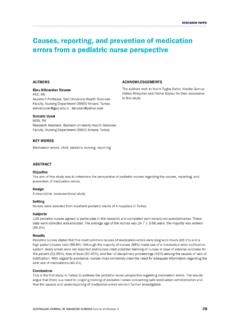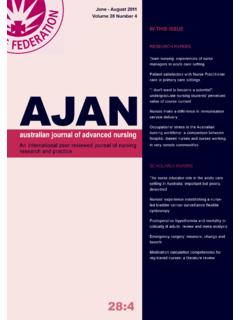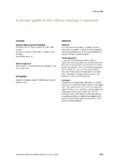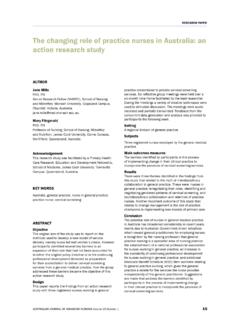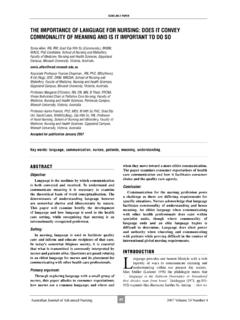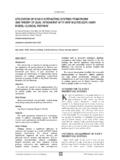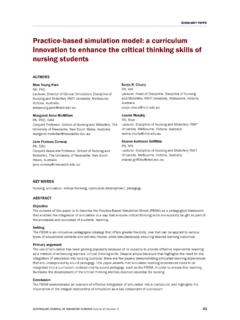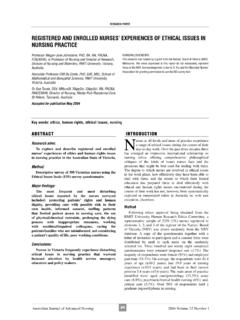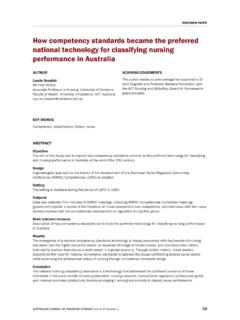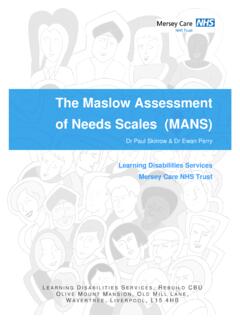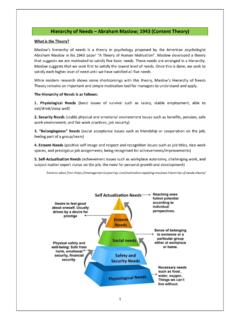Transcription of A nurses’ guide to the hierarchy of research designs and ...
1 AUSTRALIAN JOURNAL OF ADVANCED NURSING Volume 33 Issue 338 SCHOLARLY PAPERA nurses guide to the hierarchy of research designs and evidenceAUTHORR ebecca (Becky) Ingham-Broomfield JPRN (NSW), ENB249 Cardio-Thoracic Nursing (London)., , (London), BSc. (Hons), MSc (Health Psychology), Lecturer in Nursing. Armidale Rural Referral Hospital, Armidale, New South Wales, Australia WORDSE vidence based practice (EBP). Case reports, Cross-Sectional Studies, Cohort Studies, Random Control Trials, Systematic Reviews, Meta analysisABSTRACTO bjectiveThis article provides a breakdown of the components of the hierarchy , or pyramid, of research designs .
2 Its intention is to simplify the components of the hierarchy to enable novice readers of research to better understand the differing approaches and levels of ArgumentEvidence-based Practice (EBP) is the integration of the best research evidence with clinical expertise and the patient s unique circumstances. This includes respect of patient values, and their needs, whilst delivering high quality, cost effective health care. Understanding the differing levels of evidence, and their reliability, is paramount to making correct and appropriate health care decisions. Nurses are required to use evidence based practice as they are responsible for a significant amount of judgments and decisions every day, and therefore, they must use research literature as part of their clinical decision content, or levels of evidence, of the hierarchy will be discussed in a systematic, logical order from the base to the apex of the pyramid.
3 A comparative grid at the end may lead the nurse to better understand the differing components of the seven levels of evidence or, depending on the source, eight. AUSTRALIAN JOURNAL OF ADVANCED NURSING Volume 33 Issue 339 SCHOLARLY PAPERINTRODUCTIONThe nursing research pyramid, or nursing research hierarchy of evidence, provides a visual and systematic depiction of forms of research from the least reliable (base) to the most reliable (apex). The pyramid includes both qualitative and quantitative paradigms. Pyramids vary slightly from source to source which can be confusing. To further add to the varying hierarchies there is currently no universally agreed upon hierarchy of evidence for study types that seek to answer questions about patient s experiences and concerns (Del Mar et al 2013 ).
4 Figures 1 and 2 are discussed in the main part of this the Base of the Pyramid (Level 7): Ideas, Opinions, Anecdotes and EditorialsThe least reliable evidence comes from ideas, opinions, anecdotes and editorials. Our knowledge comes from varying places and our practices can be from tradition and custom, with many practices ritualistic. We can accept those practices with little questioning (Usher and Fitzgerald 2008 ). Whilst personal ideas, opinions and experience can be useful, they may not be transferrable or easily explained. They are akin to anecdotal evidence which is based on, or consists of, reports or observations of usually unscientific observers (Merriam Webster Dictionary 2015).
5 Editorials are usually in the form of a newspaper or magazine article that give the opinion of the editor or publisher (Merriam Webster Dictionary 2015). They are printed and available for public view and scrutiny but cannot be used as scientific evidence. Another form of evidence not mentioned in the pyramid is instinct which is a hunch or gut feeling which is closely tied to personal experience (Usher and Fitzgerald 2008 ). Benner (1984) believes this is often deep knowledge derived from many hours, even years, of observation and experience, and acknowledges its importance, but it remains under-researched (Usher and Fitzgerald 2008 ) and cannot be quantified.
6 It is, however, an important tool in nursing practice and part of nurses synergistic response to patients and events (Center for Spirituality & Healing and Charlson Meadows 2015).Case Controlled Studies, Case series and Case Reports (Level 6)A case controlled study, or a case report, can be defined as an in-depth research study of an individual unit which may include, for example, one person, one family, a group or other social unit (Burns and Grove, 2009; Jackson and Borbasi 2008 ). A case study generally combines both qualitative and quantitative data (Jackson and Borbasi, 2008).
7 This is further described by Wilczynski and McKibbon (2013 ) as an original study but specifically one study only. Jirowong and Pepper (2013 ) suggest that case controlled studies have subjects with a disease or condition (cases) or don t (controls). Information is obtained about their previous exposure/non exposure to the intervention or factor under study (NHMRC (National Health and Medical research Council) 2009). Comparisons can then be made by the researchers. There is a potential for bias in recalling information and the quality may be affected if the information is collected retrospectively (Jirojwong and Pepper 2013).
8 A case series is defined as a report on a series of patients, or cases, who have an outcome of interest or may have received some intervention (Del Mar et al 2013) whereas the NHMRC (2009) state it is a single group of people exposed to a intervention (factor under study). Whilst pre and post tests are recorded, there is no control group (Del Mar et al 2013 ). Due to the individual nature of these studies, with limited ability to extrapolate to a wider audience, they remain at the lower part of the Studies (Level 5)Cohort Studies are defined by Jirawong and Pepper (2013 ) as a study which categorises participants according to the level of exposure to risk factors who are then followed over a period of time to observe the AUSTRALIAN JOURNAL OF ADVANCED NURSING Volume 33 Issue 340 SCHOLARLY PAPER possible occurrence of a disease.
9 This is further clarified by Del Mar et al (2013 ) as a longitudinal, observational study where differences in outcome are observed and related to the initial differences. The NHMRC (2009 ) state that those under study are then compared to a group not exposed to the risk factor. Cohort studies can be prospective or retrospective. The NHMRC (2009 ) explain that prospective cohorts are observed at a point in time to be exposed or not exposed to an intervention whereas retrospective studies are usually done from medical studies are good at answering questions about prognosis, diagnosis, frequency and aetiology but not questions regarding the effect of an intervention (Del Mar et al 2013 ).
10 Random Controlled Trials are able to quantify the effects of intervention hence they are higher up the pyramid than Cohort Control Trials (Level 4)Random Control Trials, or RCT s, are the gold standard but Meta analyses (discussed below) combine many RCT s. RCT s are considered to provide the best evidence (Koch et al 2008 ). This is an experimental form of research where participants are randomised (randomly allocated) in to two, or more, different groups with each group receiving a different intervention. At the end of the trial the effects of the different interventions are then measured (Del Mar et al 2013 ).
